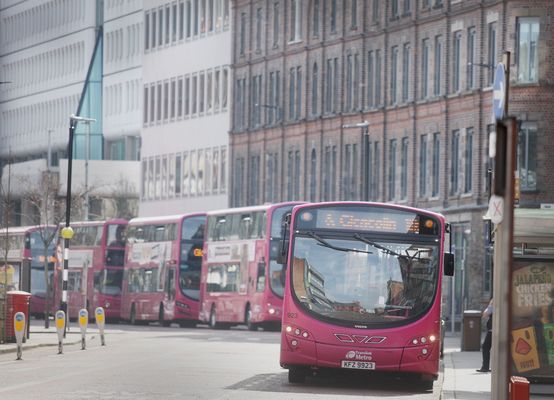AS the campaign to save Belfast's iconic and historically significant Assembly Rooms gathers pace, historian Seán Napier has said the building should be given back to the people of Belfast – which was the building's original purpose.
Seán, who hosts the popular 1798 Walking Tours in the city, said himself and others have been campaigning for many years to have the building saved from ruin and restored to its formal glory.
“This renewed interest is a good thing, I’ve been campaigning with a lot of other groups and individuals to get the building back into public ownership," he said. "It would be a very positive thing for the council and I think there is a lot of support across the council for this across all parties. All parties know the significance of this building.
“The present building has been completely changed and wrecked and it’s now missing the middle floor where the big Assembly room and meeting rooms were. The building has changed a lot both outside and inside from its early days but behind the present day skin that you see, the old Assembly rooms is there underneath."
Will we be waiting for chunks to fall off the Assembly Rooms before something is done with it? pic.twitter.com/UYidPcfdAQ
— Brendan Harkin 💀 (@brendanjharkin) February 17, 2024
Speaking about the history of the building, Seán said it had survived the city's tumultuous history and deserved to be returned to the people of the city.
Seán said: “On the outside the building was very similar in appearance to what the old Northern Whig building looks like today. During the Blitz the Northern Whig building was burned and everywhere around there was flattened apart from the Assembly Rooms but they rebuilt the Northern Whig back to what it originally looked like. The Northern Whig was built to match the appearance of the Assembly Rooms.
“The building represents all of the people of Belfast and it was built for the people of Belfast, so I think it’s about time the building was returned to its original purpose."
The building itself is famous for being a focal point of Belfast's 18th Century radicalism but it was also the stage on which United Irishman and republican hero Henry Joy McCracken was sentenced to death for his part in the 1798 rebellion.
“Famously the Assembly Rooms was used for the trial of Henry Joy McCracken," said Seán. "It's where they tried to get him to turn on his comrades and give them up. He refused to inform and was faithful to the last. His father and sister Mary Ann McCracken were there for the trial and Henry Joy famously asked his father for advice and was told to do what you think is honest and best. Henry said thank you very much and was taken away and hanged a number of hours later on High Street."
Council have agreed to my request and will assess the Assembly Rooms tomorrow to see the condition of the building and if is safe.
— Cllr Brian Smyth (@Briansmyth99) February 19, 2024
I'll keep people posted on this and anything else related as we proceed. https://t.co/eu1M54XpPI
Even before the rebellion the Rooms were a hub for radical organising and also the famous 1792 Belfast Harping Festival, which revived many of the traditional harp scores which are still played today and effectively stopped the ancient art from being lost for ever.
“The building was also famous for an event in 1793 when the United Irishmen and the Belfast Volunteers barricaded themselves into the Assembly Rooms and refused the British Yeomanry access. The Yeomanry had been terrorising republican Presbyterians in Belfast following the execution of the French King Louis XVI in Paris.
"In April the Yeomanry on horseback stabbed many citizens with their swords and it caused a mini riot after the Volunteers and the United Irishmen refused to let them enter the rooms.
“In 1792 it was also the place the Belfast Harp Festival was held which was organised by Edward Bunting and several United Irishmen which saved and preserved Irish harping music which is still played today. Wolfe Tone was up there for it too, he was up on the beer with Edward Bunting so you had all the top United Irishmen of the day listening to the revival of Irish harping – and also getting drunk!
“Tone was also suffering a big hangover from the festival when he wrote in his diary in July 1792, ‘The Harpers again. Strum Strum and be hang'd!’"
🎶 #RaglanRoad The music put to Patrick Kavanaghs poem is 'The Dawning Of The Day' (Fáinne Geal an Lae) one of the pieces transcribed & saved by 19yr old Edward Bunting! at the Belfast Harp Festival #AssemblyRooms - organised by the Belfast #UnitedIrishmen in 1792.#enlightenment https://t.co/PeUEVE4CDz
— The 1798 Belfast & Dublin Walking Tours (@1798walkingtour) April 4, 2024
Seán also noted the Assembly Rooms was the focal point of a famous scene in which United Irishman and slavery abolitionist Thomas McCabe stopped several Belfast merchants from putting their money together to invest in a slaving ship.
“When McCabe found out several merchants including Waddell Cunningham were planning on forming a Belfast-based slavery company he marched into the Assembly Rooms and put a halt to it and there’s the famous line from McCabe which said ‘May God eternally damn the soul of the man who subscribes the first guinea'.”
🟩 At the Belfast Assembly Rooms we talk about how it witnessed a key confrontation over slavery; how the inclusivity of the creators of Irish republicanism saved mainstays of music there; and how it hosted the trial of Henry Joy McCracken and others involved in 1798 rebellion.… pic.twitter.com/Kjze0gWo0q
— The 1798 Belfast & Dublin Walking Tours (@1798walkingtour) February 18, 2024
Speaking about the future of the Assembly Rooms, Seán said that he believes it should be given back to the people of Belfast, as that was its intended use, but also said it could be used as a museum to explore Belfast’s radical past.
“I think the building should be returned to its original purpose, some have suggested it is repurposed as a Troubles museum but I don’t agree with that. I think a better use would be to explore the history of radical Belfast, of the radical Presbyterians and United Irishmen and those who campaigned against slavery within these walls. Inside these walls the people of Belfast wrote to the newly formed French Republic congratulating them on the revolution and the French Republic wrote back.
“The ideas of American revolutionaries were also freely debated here, it was a home for the Enlightenment. I feel a much better purpose would be to open up a museum and also involve the French and American embassies to highlight how thinkers from Belfast – and in that very building – influenced ideas such as democracy and liberty which reverberated around the world.”







